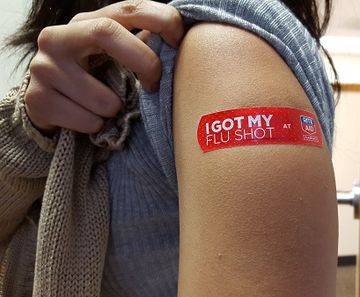By JULIE APPLEBY
The pharmacy chain pitches started in August: Come in and get your flu shot.
Convenience is touted. So are incentives: CVS offers a 20-percent-off shopping pass for everyone who gets a shot, while Walgreens donates toward international vaccination efforts.
The start of flu season is still weeks — if not months — away. Yet marketing of the vaccine has become an almost year-round effort, beginning when the shots become available in August and hyped as long as the supply lasts, often into April or May.
Not that long ago, most flu-shot campaigns started as the leaves began to turn in October. But the rise of retail medical clinics inside drug stores over the past decade — and state laws allowing pharmacists to give vaccinations — has stretched the flu-shot season.
The stores have figured out how “to deliver medical services in an on-demand way” which appeals to customers, particularly millennials, said Tom Charland, founder and CEO of Merchant Medicine, which tracks the walk-in clinic industry. “It’s a way to get people into the store to buy other things.”
But some experts say the marketing may be overtaking medical wisdom since it’s unclear how long the immunity imparted by the vaccine lasts, particularly in older people.
Federal health officials say it’s better to get the shot whenever you can. An early flu shot is better than no flu shot at all. But the science is mixed when it comes to how long a flu shot promoted and given during the waning days of summer will provide optimal protection, especially because flu season generally peaks in mid-winter or beyond. Experts are divided on how patients should respond to such offers.
“If you’re over 65, don’t get the flu vaccine in September. Or August. It’s a marketing scheme,” said Laura Haynes, an immunologist at the University of Connecticut Center on Aging.
That’s because a combination of factors makes it more difficult for the immune systems of people older than age 65 to respond to the vaccination in the first place. And its protective effects may wear off faster for this age group than it does for young people.
When is the best time to vaccinate? It’s a question even doctors have.
“Should I wait until October or November to vaccinate my elderly or medically frail patients?” That’s one of the queries on the website of the board that advises the Centers for Disease Control and Prevention on immunizations. The answer is that it is safe to make the shots available to all age groups when the vaccine becomes available, although it does include a caution.
The board says antibodies created by the vaccine decline in the months following vaccination “primarily affecting persons age 65 and older,” citing a study done during the 2011-2012 flu season. Still, while “delaying vaccination might permit greater immunity later in the season,” the CDC notes that “deferral could result in missed opportunities to vaccinate.”
How long will the immunity last?
“The data are very mixed,” said. John J. Treanor, a vaccine expert at the University of Rochester medical school. Some studies suggest vaccines lose some protectiveness during the course of a single flu season. Flu activity generally starts in the fall, but peaks in January or February and can run into the spring.
“So some might worry that if [they] got vaccinated very early and flu didn’t show up until very late, it might not work as well,” he said.
But other studies “show you still have protection from the shot you got last year if it’s a year when the strains didn’t change, Treanor said.
In any given flu season, vaccine effectiveness varies. One factor is how well the vaccines match the virus that is actually prevalent. Other factors influencing effectiveness include the age and general health of the recipient. In the overall population, the CDC says studies show vaccines can reduce the risk of flu by about 50 to 60 percent when the vaccines are well matched.
Health officials say it’s especially important to vaccinate children because they often spread the disease, are better able to develop antibodies from the vaccines and, if they don’t get sick, they won’t expose grandma and grandpa. While most people who get the flu recover, it is a serious disease responsible for many deaths each year, particularly among older adults and young children. Influenza’s intensity varies annually, with the CDC saying deaths associated with the flu have ranged from about 3,300 a year to 49,000 during the past 31 seasons.
To develop vaccines, manufacturers and scientists study what’s circulating in the Southern Hemisphere during its winter, which is our summer. Then — based on that evidence — forecast what flu strains might circulate here to make vaccines that are generally delivered in late July.
For the upcoming season, the vaccines will include three or four strains, including two A strains, an H1N1 and an H3N2, as well as one or two B strains, according to the CDC. It recommends that everyone older than 6 months get vaccinated, unless they have health conditions that would prevent it.
The vaccines can’t give a person the flu because the virus is killed before it’s included in the shot. This year, the nasal vaccine is not recommended for use, as studies showed it was not effective during several of the past flu seasons.
But when to go?
“The ideal time is between Halloween and Thanksgiving,” said Haynes at UConn. “If you can’t wait and the only chance is to get it in September, then go ahead and get it. It’s best to get it early rather than not at all.”




